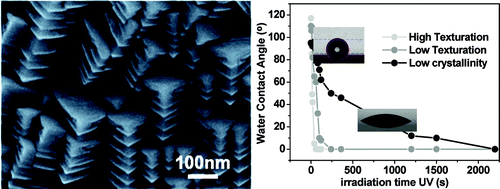A. Borrás, A.R. González-Elipe
Langmuir, 26 (2010) 15875–15882
doi: 10.1021/la101975e

This work presents a thorough study on the wettability of polycrystalline anatase TiO2 thin films prepared at 250 °C in a microwave plasma enhanced chemical vapor deposition (MW-PECVD) reactor with Ar/O2 plasmas. Anatase polycrystalline thin films with different microstructures, textures, and surface roughness were obtained as a function of their thickness. The water contact angle of the samples was analyzed within the assumptions of the Wenzel, Cassie, and Miwa models to ascertain the effect of roughness and other surface heterogeneities on their characteristic parameters. The roughness factors defined in the different models were calculated from the atomic force microscopy (AFM) images of the films for two different observation scales within the premises of the dynamic scaling theories. The obtained results indicate that the wetting angle of an equivalent flat anatase surface with a value of 82° can only be properly estimated for observation scales of 5 × 5 μm2 and using the Miwa model. The analysis of the UV induced hydrophilization of the surface state of the anatase films and the posterior recovery of the partially hydrophobic character of these surfaces in the absence of UV photons suggest a clear dependence of the light induced wettability on their texture and size of crystalline domains.

